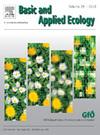Limited immediate effect of artificial light of realistic intensity on flight behaviour of commuting pond bat (Myotis dasycneme)
IF 3.5
2区 环境科学与生态学
Q2 ECOLOGY
引用次数: 0
Abstract
Artificial light at night can act as a barrier and cause habitat fragmentation, especially for bat species that are generally considered to be light-averse. Bats use linear structures to commute from their roost to their foraging areas. Trawling bats such as the pond bat (Myotis dasycneme) forage predominantly above water bodies and use waterways as commuting routes. Artificial light along these potentially leads to interruptions of commuting routes, or changes in flight behaviour of trawling bats, but impact of light may vary with light spectrum and intensity. Here, we tested whether pond bats change their flight speed and straightness in response to four light spectra at two light intensities by placing an experimental lamp post at bridges over waterways that are used by pond bats as commuting routes. We used a microphone array to precisely reconstruct the flight path of each passing bat and calculate flight parameters. Flight speed of commuting pond bats was unaffected by the presence of light, regardless of the light spectrum. Pond bats only fly straighter when exposed to white light (3000 K). The short presence of a lamp post with realistic light intensity on a bridge may therefore not act as a barrier. However, other direct effects cannot be excluded and the long-term presence of a similar light installation may still have impact.
真实强度人工光对塘蝠飞行行为的有限即时影响
夜间的人造光可以作为屏障,导致栖息地破碎,特别是对于通常被认为厌恶光线的蝙蝠物种。蝙蝠使用线性结构往返于它们的栖息地和觅食区之间。拖网蝙蝠,如塘蝠(Myotis dasycneme)主要在水体上方觅食,并将水道作为通勤路线。沿着这些道路的人造光可能会导致通勤路线的中断,或改变拖网蝙蝠的飞行行为,但光的影响可能会随着光谱和强度而变化。在这里,我们测试了塘蝠在两种光强度下对四种光谱的反应是否会改变它们的飞行速度和直线度,方法是在塘蝠通勤路线的水道上的桥梁上放置一个实验灯柱。我们使用麦克风阵列精确地重建每只蝙蝠的飞行路径,并计算飞行参数。无论光谱如何,塘蝠的飞行速度都不受光的影响。塘蝠只有在暴露于白光(3000k)下才会飞得更直。因此,桥上短暂存在的具有真实光强的灯柱可能不会起到屏障的作用。然而,不能排除其他直接影响,长期放置类似的照明装置仍可能产生影响。
本文章由计算机程序翻译,如有差异,请以英文原文为准。
求助全文
约1分钟内获得全文
求助全文
来源期刊

Basic and Applied Ecology
环境科学-生态学
CiteScore
6.90
自引率
5.30%
发文量
103
审稿时长
10.6 weeks
期刊介绍:
Basic and Applied Ecology provides a forum in which significant advances and ideas can be rapidly communicated to a wide audience. Basic and Applied Ecology publishes original contributions, perspectives and reviews from all areas of basic and applied ecology. Ecologists from all countries are invited to publish ecological research of international interest in its pages. There is no bias with regard to taxon or geographical area.
 求助内容:
求助内容: 应助结果提醒方式:
应助结果提醒方式:


